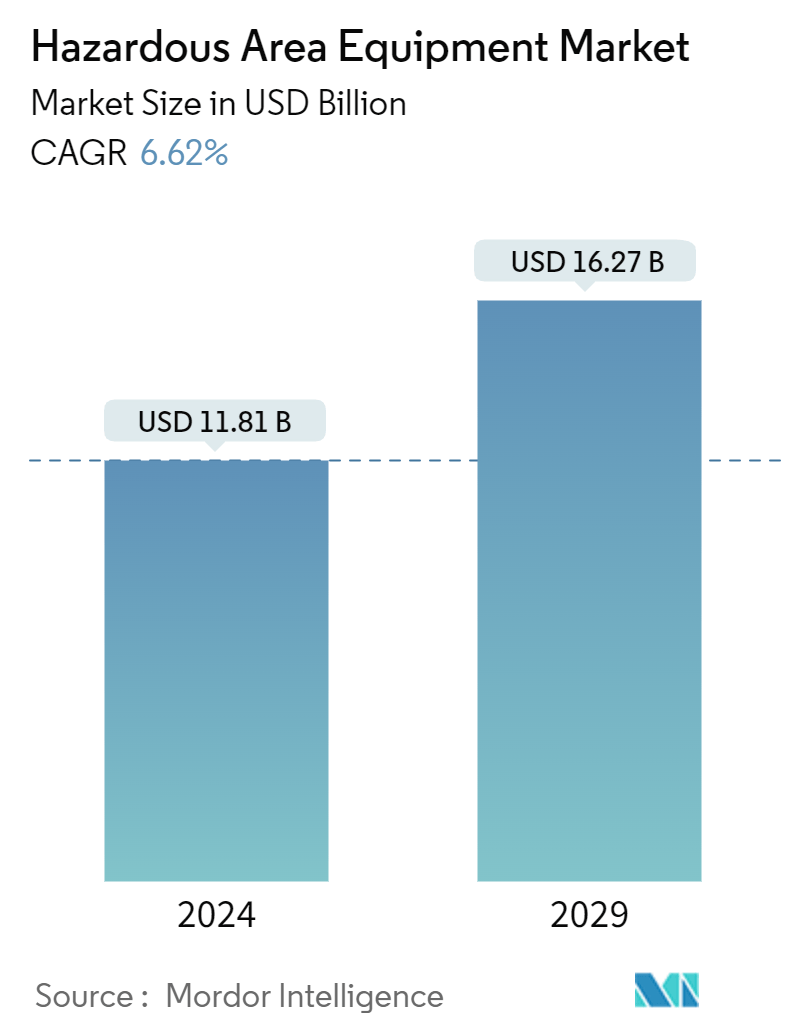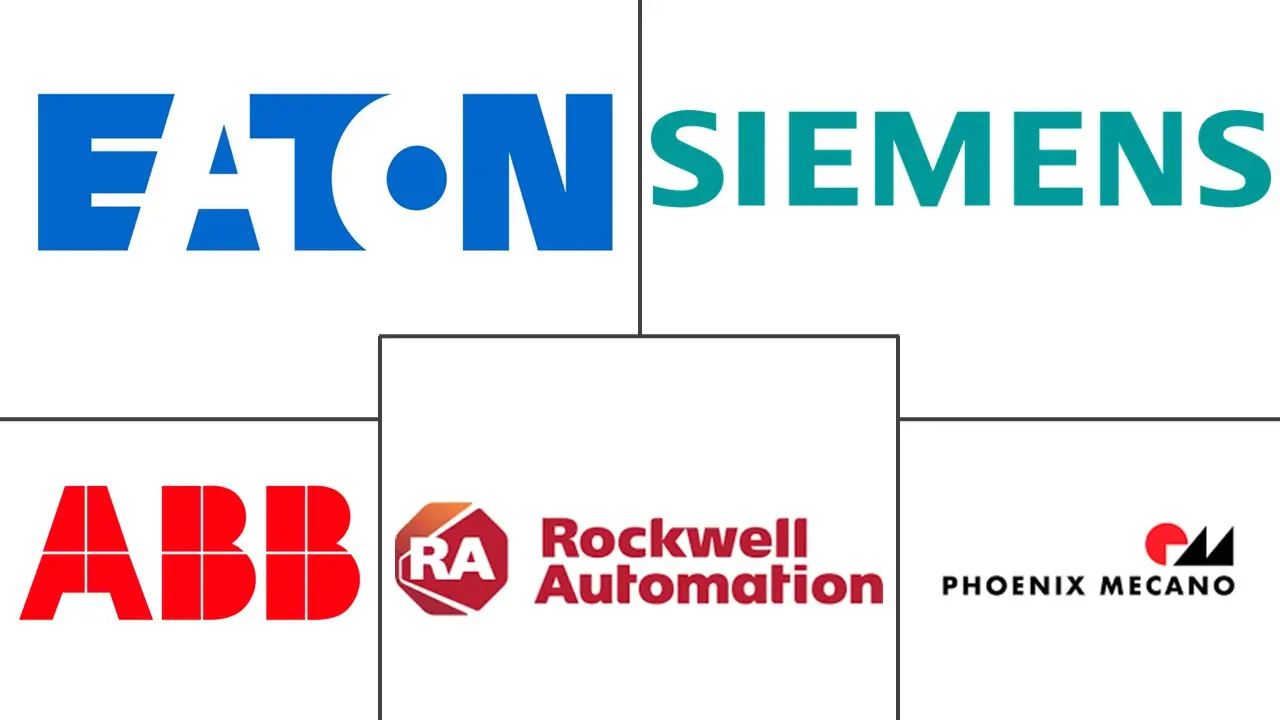Market Size of Hazardous Area Equipment Industry

| Study Period | 2019 - 2029 |
| Market Size (2024) | USD 11.81 Billion |
| Market Size (2029) | USD 16.27 Billion |
| CAGR (2024 - 2029) | 6.62 % |
| Fastest Growing Market | Asia Pacific |
| Largest Market | Asia Pacific |
Major Players
*Disclaimer: Major Players sorted in no particular order |
Hazardous Area Equipment Market Analysis
The Hazardous Area Equipment Market size is estimated at USD 11.81 billion in 2024, and is expected to reach USD 16.27 billion by 2029, growing at a CAGR of 6.62% during the forecast period (2024-2029).
Equipment for hazardous areas is specifically designed for use in environments that are highly explosive due to the presence of combustible air-flammable gases or particulate combinations. There are multiple schemes that outline the standards for the safe design, functioning, and management of such equipment. The terminology used to describe hazards and protective measures can also vary. It is important to note that the presence of such an atmosphere is common or at least possible in numerous industrial, commercial, and scientific settings. Ensuring fire and explosion protection is crucial for the safety of employees and the reliability of operations.
- The demand for hazardous area equipment is being driven by the implementation of safety regulations by various governments and the need to prevent accidents and explosions in hazardous environments. The market growth is also being propelled by technological advancements in equipment design and the growing emphasis on energy efficiency.
- Although the hazardous area equipment industry has experienced growth, there are several factors that impede its further development. The significant expenses associated with the equipment and the necessity for qualified professionals to operate them are the primary obstacles affecting market expansion.
- The absence of uniform standards and certification for hazardous area equipment, along with the limited accessibility of these products in remote areas, pose substantial challenges to the market's growth.
- There is also a growing demand for flame- and explosion-proof hazardous area equipment, such as industrial controllers, cable glands, motors, sensors, strobe beacons, lighting, and other related items, due to the heightened emphasis on safety measures in sectors like process and cooling industries. Also, the increasing focus on enhancing safety measures in various industries, specifically in process and cooling sectors, is leading to a rise in demand for hazardous area equipment and is expected to experience substantial growth in the forecast period.
- The equipment used in the hazardous area is securely enclosed to prevent any potential hazards. These equipment are typically made of sturdy materials such as die-cast steel and sometimes plastic. The enclosure effectively prevents explosions in case of faulty equipment generating heat or sparks.
- Additionally, different countries have their own methods of ensuring the safety of equipment used in hazardous areas. While these equipment offers benefits, their deployment can be quite costly, and they can become quite heavy. As a result, the high initial cost of implementing hazardous area equipment is hindering market growth.
Hazardous Area Equipment Industry Segmentation
Hazardous area and explosion-proof equipment are electrical and non-electrical fixtures that can prevent and withstand explosions. An explosion-proof piece of equipment has an apparatus enclosed in a case capable of withstanding an explosion of a specific gas or vapor that may occur within it.
Hazardous area equipment finds its applications in diverse industries, such as aerospace and aircraft maintenance sites, construction sites, HVAC systems, manufacturing and machine processing units, mining fields, and oil and gas extraction fields. Lighting, surveillance, and signaling systems are some of the preferred types of equipment across industries.
The study tracks the revenue accrued from the sale of hazardous location equipment in the global market. Equipment for hazardous areas is specifically designed for use in highly explosive environments due to combustible air-flammable gases or particulate combinations. Multiple schemes outline the standards for such equipment's safe design, functioning, and management. The terminology used to describe hazards and protective measures can also vary. It is important to note that the presence of such an atmosphere is common or at least possible in numerous industrial, commercial, and scientific settings. Ensuring fire and explosion protection is crucial for employees' safety and operations' reliability.
The hazardous area equipment market is segmented by equipment (power supply systems, electric motors, surveillance systems, cable glands and connectors, automation and control products, enclosures, lighting products, push buttons and signaling devices), by end-user industry (oil and gas, energy and power generation, chemical, food and beverage, pharmaceuticals and other end-user industries), by geography (North America, United States, Canada), Europe (United Kingdom Germany, France Spain, Italy, Benelux Rest of Europe), Asia-Pacific (China, India, Japan, South Korea, Australia and New Zealand and Rest of Asia-Pacific), Latin America (Mexico, Brazil, Rest of the Latin America) Middle East and Africa (United Arab Emirates, Saudi Arabia, South Africa, Rest of Middle East and Africa). The market sizes and forecasts are provided in terms of value in USD for all the above segments.
| By Equipment | |
| Power Supply Systems | |
| Electric Motors | |
| Surveillance Systems | |
| Cable Glands and Connectors | |
| Automation and Control Products | |
| Enclosures | |
| Lighting Products | |
| Push Buttons and Signaling Devices |
| By End-user Industry | |
| Oil and Gas | |
| Energy and Power Generation | |
| Chemical | |
| Food and Beverage | |
| Pharmaceuticals | |
| Other End-user Industries |
| By Geography | |||||||||||
| |||||||||||
| |||||||||||
| |||||||||||
| |||||||||||
|
Hazardous Area Equipment Market Size Summary
The hazardous area equipment market is poised for significant growth, driven by the increasing need for safety in environments prone to explosions due to combustible gases or dust. This equipment is essential across various sectors, including oil and gas, manufacturing, and chemicals, where the risk of fire and explosion is a concern. The market is influenced by stringent safety regulations and technological advancements that enhance energy efficiency and equipment design. Despite the growth, challenges such as high costs, the need for skilled professionals, and the lack of uniform standards hinder further expansion. The demand for flame- and explosion-proof equipment is rising, particularly in the process and cooling industries, as safety measures become more critical.
The market landscape is competitive, with established players like ABB Ltd, Eaton Corporation, Honeywell International Inc., Siemens AG, and Rockwell Automation Inc. leading the charge. These companies focus on innovation and strategic partnerships to maintain their market position. New entrants and startups are also emerging, bringing innovative solutions to the market. The oil and gas industry's expansion, coupled with increased manufacturing activities in regions like China and India, is expected to drive demand for hazardous area equipment. Additionally, investments in infrastructure and exploration in countries such as India further bolster market growth prospects.
Hazardous Area Equipment Market Size - Table of Contents
-
1. MARKET INSIGHTS
-
1.1 Market Overview
-
1.2 Industry Attractiveness - Porter's Five Forces Analysis
-
1.2.1 Bargaining Power of Suppliers
-
1.2.2 Bargaining Power of Buyers
-
1.2.3 Threat of New Entrants
-
1.2.4 Intensity of Competitive Rivalry
-
1.2.5 Threat of Substitutes
-
-
1.3 Industry Value Chain Analysis
-
1.4 An Assessment of Macro Trends Impact on the Industry
-
-
2. MARKET SEGMENTATION
-
2.1 By Equipment
-
2.1.1 Power Supply Systems
-
2.1.2 Electric Motors
-
2.1.3 Surveillance Systems
-
2.1.4 Cable Glands and Connectors
-
2.1.5 Automation and Control Products
-
2.1.6 Enclosures
-
2.1.7 Lighting Products
-
2.1.8 Push Buttons and Signaling Devices
-
-
2.2 By End-user Industry
-
2.2.1 Oil and Gas
-
2.2.2 Energy and Power Generation
-
2.2.3 Chemical
-
2.2.4 Food and Beverage
-
2.2.5 Pharmaceuticals
-
2.2.6 Other End-user Industries
-
-
2.3 By Geography
-
2.3.1 North America
-
2.3.1.1 United States
-
2.3.1.2 Canada
-
-
2.3.2 Europe
-
2.3.2.1 United Kingdom
-
2.3.2.2 Germany
-
2.3.2.2.1 Market Share by Product Category and End-user Industry
-
2.3.2.2.2 List of Manufacturers of Hazardous Equipment
-
-
2.3.2.3 France
-
2.3.2.4 Spain
-
2.3.2.5 Italy
-
2.3.2.6 Benelux
-
-
2.3.3 Asia
-
2.3.3.1 China
-
2.3.3.2 India
-
2.3.3.3 Japan
-
2.3.3.4 South Korea
-
2.3.3.5 Australia and New Zealand
-
-
2.3.4 Latin America
-
2.3.4.1 Mexico
-
2.3.4.2 Brazil
-
-
2.3.5 Middle East and Africa
-
2.3.5.1 United Arab Emirates
-
2.3.5.2 Saudi Arabia
-
2.3.5.3 South Africa
-
-
-
Hazardous Area Equipment Market Size FAQs
How big is the Hazardous Area Equipment Market?
The Hazardous Area Equipment Market size is expected to reach USD 11.81 billion in 2024 and grow at a CAGR of 6.62% to reach USD 16.27 billion by 2029.
What is the current Hazardous Area Equipment Market size?
In 2024, the Hazardous Area Equipment Market size is expected to reach USD 11.81 billion.

